Musculoskeletal Disorders Drugs Market Research, 2032
The global musculoskeletal disorders drugs market size was valued at $83.5 billion in 2022, and is projected to reach $126 billion by 2032, growing at a CAGR of 4.2% from 2023 to 2032. Musculoskeletal disorders (MSDs) are injuries and disorders that affect the human body's movement or musculoskeletal system, which includes bones, muscles, tendons, ligaments, nerves, discs, and blood vessels. Musculoskeletal disorders (MSDs) can affect many different parts of the body, including the upper and lower back, neck, shoulders, and extremities such as the arms, legs, hands, and feet. These disorders can manifest in a variety of ways, such as pain, stiffness, swelling, weakness, and limited range of motion. The symptoms of musculoskeletal disorders include stiff joints, swelling, dull aches, and recurrent pain. Musculoskeletal disorders drugs include a range of medications such as analgesics, corticosteroids, and disease-modifying anti-rheumatic drugs (DMARDs). These drugs work in different ways to manage pain, inflammation, and other symptoms associated with these conditions.
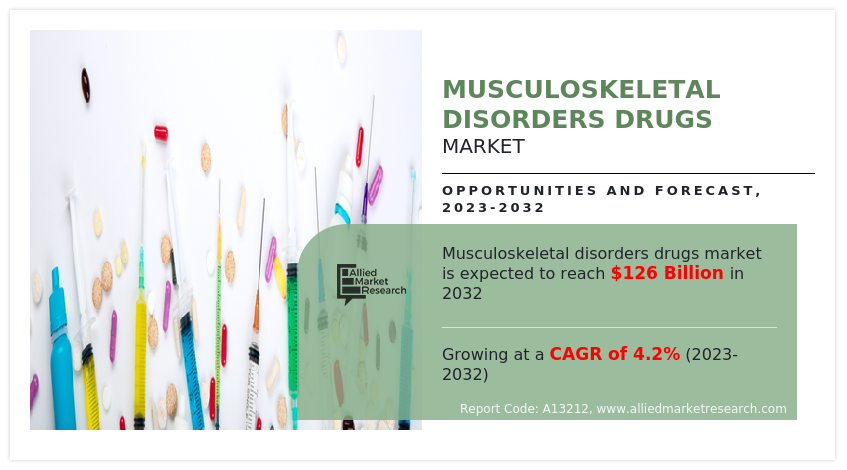
“The musculoskeletal disorder drugs market was decreased during the lockdown period owing to decline in sales of musculoskeletal disorder drugs such as analgesics. In addition, many clinical trials for musculoskeletal disorder drugs had delayed or postponed. This has resulted in a slowdown in the development of new drugs, which ultimately negatively impacted the growth of the musculoskeletal disorders drugs market size.”
Market Dynamics
Rise in incidences and prevalence of musculoskeletal disorders is due to various factors, such as aging population, sedentary lifestyles, obesity, and a higher incidence of work-related injuries. For instance, according to the World Health Organization (WHO), approximately 1.71 billion people have musculoskeletal conditions worldwide in 2022. Thus, rise in prevalence of musculoskeletal disorders has increased the demand for treatment options and support the growth musculoskeletal disorders drugs market share. In addition, increase in awareness among patients about importance of early diagnosis and treatment of MSDs which is driving the demand for musculoskeletal disorder drugs. Rise in product launches for musculoskeletal disorder drugs by various key players across the globe is set to affect the market growth positively. For instance, in May 2020, Teva and Celltrion Healthcare announce the launch of TRUXIMA (rituximab-abbs) injection for rheumatoid arthritis, the only biosimilar to Rituxan (rituximab) available in the U.S.
The demand for musculoskeletal disorder drugs is not only limited to developed countries but is also being witnessed in the developing countries, such as China, Brazil, and India, which fuel the growth of the musculoskeletal disorders drugs market share. Factor such as increase in awareness toward early diagnosis and treatment further drive the growth of the market. Moreover, increase in promotional activities by manufacturers is expected to fuel their adoption in the near future.
Furthermore, growing geriatric population is particularly susceptible to musculoskeletal disorders, such as rheumatoid arthritis, osteoarthritis and osteoporosis. As the number of older adults increases globally, led to increase in demand for musculoskeletal disorder drugs and further drive the musculoskeletal disorders drugs market growth.
Moreover, improved healthcare expenditure, and surge in demand for amyotrophic lateral sclerosis drugs. Furthermore, the healthcare industry in emerging economies is developing at a significant rate, owing to rise in demand for enhanced healthcare services, and significant investments by government to improve healthcare infrastructure. E-commerce (electronic commerce) has become a vital tool for small and large businesses globally, due to rise in preference of consumers for online shopping over traditional purchasing methods. This is further supports market growth.
Lack of access to treatment for rheumatoid arthritis is a significant restraining factor for the musculoskeletal disorders drugs market. In emerging countries access to healthcare providers and specialty clinics may be limited. This can make it difficult for patients to receive timely diagnosis and treatment for their musculoskeletal conditions, leading to delays in care and increased risk of disability.
The global musculoskeletal disorder drugs market experienced a decline in 2020 due to global economic recession led by COVID-19. The COVID-19 pandemic had a significant impact on the musculoskeletal disorders drugs market, as it has disrupted supply chains and caused delays in clinical trials and drug development. The pandemic led to a decrease in patient visits to healthcare providers, which has affected the diagnosis and treatment of musculoskeletal disorders. In addition, the COVID-19 outbreak disrupted the supply chain across various end-user industries like food & beverage, healthcare, and industrial. However, the market is anticipated to witness recovery in 2021, and show stable growth for musculoskeletal disorder drugs market in the coming future. This is attributed to the increase in prevalence of musculoskeletal disorders drugs, wide availability of drugs options, continuous approval of drugs for musculoskeletal drugs.
Segmental Overview
The musculoskeletal disorder drugs market is segmented into drug type, route of administration, distribution channel and region. By drug type, the market is categorized into analgesics, DMARDs, corticosteroids, and others. By route of administration, the market is segregated into oral and parenteral. By distribution channel, the market is classified into hospital pharmacies, online providers, and drug stores and retail pharmacies. Region wise, the market is analyzed across North America, Europe, Asia-Pacific, and LAMEA.
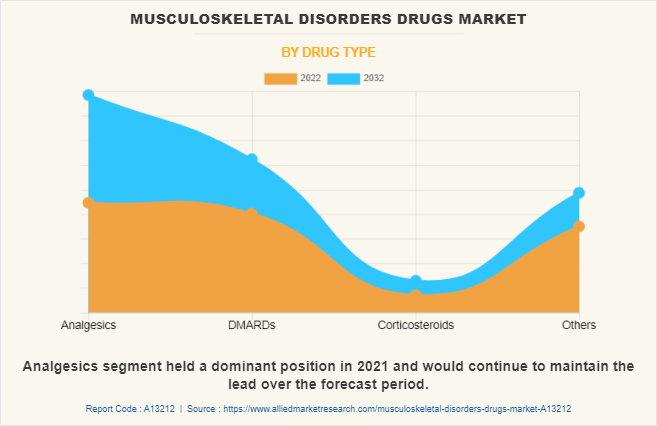
By Drug Type:
The musculoskeletal disorder drugs market is segmented into analgesics, DMARDs, corticosteroids, and others. The analgesics segment dominated the global market in 2022. Cost-effectiveness of analgesics is driving their demand in the musculoskeletal disorders drugs market. In addition, analgesics are generally cost-effective compared to other medications used to treat musculoskeletal disorders, such as disease-modifying antirheumatic drugs (DMARDs) and biologics, thereby drive the segment growth.
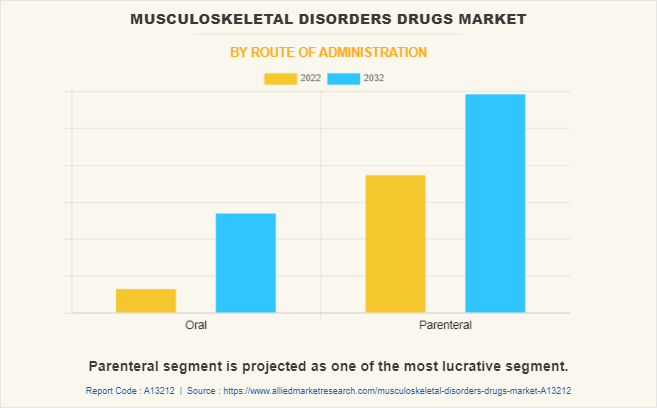
By Route of Administration:
The musculoskeletal disorder drugs market is segregated into oral and parenteral. The parenteral segment dominated the global market in 2022. This is attributed to rise in adoption of oral drugs as they are easy to administer and effective. However, the oral segment exhibited the fastest CAGR growth during the musculoskeletal disorders drugs market forecast period. This is attributed to as many patients prefer oral medications over other forms of treatment due to convenient to administer, and less expensive than other forms of treatment.
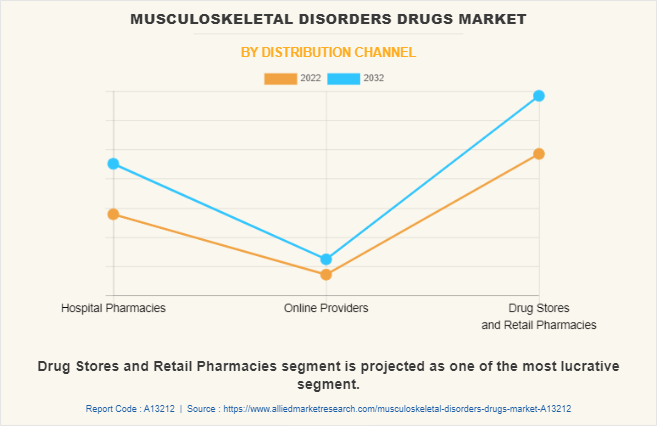
By Distribution Channel:
The market is classified into hospital pharmacies, online providers, and drug store & retail pharmacies. The drug store & retail pharmacies held the largest market share in 2022, owing to increase in number of patient suffering from musculoskeletal disorders such as rheumatoid arthritis which increases the demand for drugs in drug stores & retail pharmacies. However, online providers segment is expected to register the highest CAGR during the forecast period. This is attributed to convenient to use, lower prices, easy accessibility, and technological advancements.
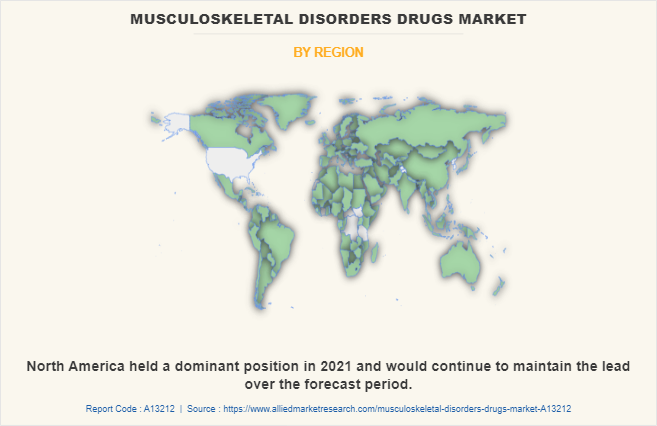
By Region:
The musculoskeletal disorder drugs market is analyzed across North America, Europe, Asia-Pacific, and LAMEA. North America accounted for a major share of the musculoskeletal disorder drugs market in 2022, and is expected to maintain its dominance during the forecast period.
Presence of several major players, such as Pfizer Inc., AbbVie Inc., and Novartis AG and advancement in manufacturing of musculoskeletal disorder drugs in the region drive the growth of the market. Furthermore, presence of well-established healthcare infrastructure, high purchasing power, and rise in adoption rate of musculoskeletal disorder drugs such as analgesics are expected to drive the market growth. Moreover, product launch and product approvals adopted by the key players in this region boost the growth of the market. In addition, rise in prevalence of musculoskeletal disorders due to a variety of factors, including sedentary lifestyles, obesity, and workplace-related injuries which increased the demand for musculoskeletal drugs to manage the conditions.
Asia-Pacific expected to grow at the highest rate during the forecast period. The market growth in this region is attributable to presence of pharmaceutical companies in the region as well as growth in the purchasing power of populated countries, such as China and India. Moreover, rise in personalized medicine expenditure and adoption analgesics drugs and disease modifying anti-rheumatic drugs (DMARDs) to treat and manage the musculoskeletal disorders which drive the growth of the market. Furthermore, the Asia-Pacific region exhibits the largest medicine supply and the largest pharmaceuticals industry with availability of raw material in abundance, which easily accessed by manufacturers of musculoskeletal disorder drugs. This, in turn, drives the growth of the musculoskeletal disorders drugs industry.
Asia-Pacific offers profitable opportunities for key players operating in the musculoskeletal disorders drugs industry, thereby registering the fastest growth rate during the forecast period, owing to the growing infrastructure of industries, increase in prevalence of musculoskeletal disorders in the region. In addition, growing aging population as they become more susceptible to musculoskeletal disorders such as osteoarthritis, rheumatoid arthritis, and osteoporosis which provides great opportunity for new entrants in this region.
Competition Analysis
Competition analysis and profiles of the major players in the musculoskeletal disorder drugs, such as AbbVie Inc., Amgen Inc. Eli Lilly and Company, F. Hoffmann-La Roche Ltd., Johnson & Johnson, Merck & Co., Inc. Novartis AG, Pfizer Inc. Teva Pharmaceutical Industries Ltd. and UCB S.A. are provided in this report. Major players have adopted product launch, and product approval as key developmental strategies to improve the product portfolio of the musculoskeletal disorder drugs market.
Recent Product Launches in the Musculoskeletal Disorders Drugs Market
In January 2023, Amgen announced AMJEVITA (adalimumab-atto), a biosimilar to Humira (adalimumab), is now available in the U.S.
In May 2022, Teva and Celltrion Healthcare announce the launch of TRUXIMA (rituximab-abbs) injection for rheumatoid arthritis, the only biosimilar to Rituxan (rituximab) available in the U.S.
Recent Approvals Approvals in the Musculoskeletal Disorders Drugs Market
In January 2022, AbbVie announced the U.S. Food and Drug Administration (FDA) has approved SKYRIZI (risankizumab-rzaa) for the treatment of adults with active psoriatic arthritis (PsA), a systemic inflammatory disease that affects the skin and joints.
In June 2022, Amgen announced that the U.S. Food and Drug Administration (FDA) has approved RIABNI (rituximab-arrx), a biosimilar to Rituxan, in combination with methotrexate for adults with moderate to severely active rheumatoid arthritis.
In September 2021, Novartis announced that the U.S. Food and Drug Administration (FDA) has granted fast track designation for LNA043 for the treatment for osteoarthritis of the knee.
In September 2020, The Janssen Pharmaceutical Companies of Johnson & Johnson announced that the U.S. Food and Drug Administration (FDA) has approved SIMPONI ARIA (golimumab) for patients 2 years of age and older for the treatment of active polyarticular juvenile idiopathic arthritis (pJIA).
In December 2021, Pfizer Inc. announced that the U.S. Food and Drug Administration (FDA) has approved the supplemental New Drug Application (sNDA) for XELJANZ/ XELJANZ XR (tofacitinib) for the treatment of adults with active ankylosing spondylitis (AS) who have had an inadequate response or intolerance to one or more tumor necrosis factor (TNF) blockers.
In November 2021, Pfizer Inc. announced that the European Commission has approved XELJANZ (tofacitinib) 5 mg twice daily for the treatment of adults with active ankylosing spondylitis (AS) who have responded inadequately to conventional therapy.
In August 2021, Pizer Inc. announced that the European Commission (EC) has approved XELJANZ (tofacitinib) for the treatment of active polyarticular juvenile idiopathic arthritis (JIA) and juvenile psoriatic arthritis (PsA) in patients two years of age and older who have responded inadequately to previous therapy with disease modifying antirheumatic drugs (DMARDs).
Key Benefits For Stakeholders
- This report provides a quantitative analysis of the market segments, current trends, estimations, and dynamics of the musculoskeletal disorders drugs market analysis from 2022 to 2032 to identify the prevailing musculoskeletal disorders drugs market opportunity.
- The market research is offered along with information related to key drivers, restraints, and opportunities.
- Porter's five forces analysis highlights the potency of buyers and suppliers to enable stakeholders make profit-oriented business decisions and strengthen their supplier-buyer network.
- In-depth analysis of the musculoskeletal disorders drugs market segmentation assists to determine the prevailing market opportunities.
- Major countries in each region are mapped according to their revenue contribution to the global market.
- Market player positioning facilitates benchmarking and provides a clear understanding of the present position of the market players.
- The report includes the analysis of the regional as well as global musculoskeletal disorders drugs market trends, key players, market segments, application areas, and market growth strategies.
Musculoskeletal Disorders Drugs Market Report Highlights
| Aspects | Details |
| Market Size By 2032 | USD 126 billion |
| Growth Rate | CAGR of 4.2% |
| Forecast period | 2022 - 2032 |
| Report Pages | 263 |
| By Drug Type |
|
| By Route of Administration |
|
| By Distribution Channel |
|
| By Region |
|
| Key Market Players | Novartis AG, F. Hoffmann-La Roche Ltd., UCB S.A., Johnson & Johnson, Amgen Inc., Eli Lilly and Company, Pfizer Inc., Teva Pharmaceutical Industries Ltd., AbbVie Inc., Merck & Co., Inc. |
Analyst Review
This section provides various opinions of top-level CXOs in the global musculoskeletal disorders drugs market. According to the insights of CXOs, the global musculoskeletal disorders drugs market is expected to exhibit high growth potential attributable to high demand for musculoskeletal disorders drugs and rise in pipeline products. Increase in awareness of musculoskeletal disorders as the more patients are being diagnosed early, leading to a higher demand for drugs that can treat and manage these conditions which is expected to drive the market growth. However, lack of access to treatment of rheumatoid arthritis in underdeveloped countries hamper the market growth.??
CXOs further added that surge in incidences of musculoskeletal disorders such as rheumatoid arthritis, osteoporosis, and osteoarthritis drive the market growth. Moreover, rise in awareness about increase in number of generic drug manufactures and increase in ageing population are some factors which further boost the market growth.??
Furthermore, North America is expected to witness the highest growth, in terms of revenue, owing to the increase in prevalence of musculoskeletal disorders along with rise in geriatric population and presence of major key players in the region. However, Asia-Pacific is anticipated to witness notable growth, owing to rise in healthcare awareness, increase in incidence of musculoskeletal disorders and easy availability of musculoskeletal drugs.
Rise in incidences and prevalence of musculoskeletal disorders such as rheumatoid arthritis, osteoporosis ankylosing spondylitis, increase in geriatric population and rise in pipeline drugs are the factors responsible for the market growth.
The leading application of musculoskeletal disorders market is the rheumatoid arthritis.
North America is the largest regional market for musculoskeletal disorders drugs owing to surge in prevalence of disease such as rheumatoid arthritis, and osteoporosis.
The estimated industry size of musculoskeletal disorders drugs in 2032 is $126,030.22 million.
Top companies such as Pfizer Inc., Johnson & Johnson, Eli Lilly and Company, Amgen Inc., and Novartis AG held high market share in 2022.
Musculoskeletal disorders drugs are a class of medications that are used to treat conditions affecting the muscles, bones, joints of body.
The forecast period for musculoskeletal disorders drugs market is 2023 to 2032
Loading Table Of Content...
Loading Research Methodology...



